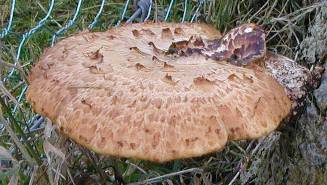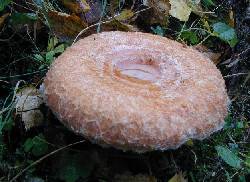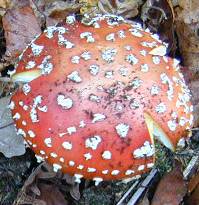
Back to the Index page
11 members and guests turned up for the last outdoor meeting of the season at Sykes House, where we had been invited by Tom and Janet Denney. Unfortunately the weather was not kind to us, with heavy showers (the first rain for several weeks) and a cold north-easterly wind; Janet’s coffee and chocolate brownies were very welcome before we started. The meeting was led by our old friends Colin and Beryl Stephenson from Scarborough.
Because of the very dry autumn it was not easy to find fungi, at least in the form of reasonably-sized “mushrooms” or toadstools. Colin did find (and identify) a fair number of mildews and other very tiny moulds on various leaves (including blackspot, which is of course a fungus, on sycamore; as an interesting sideline we learnt that this indicator of clean air can now be found in Sheffield city centre!), coral spots and the like on dead wood, and some rather splendid birch polypores. Brian Cockerill found an interesting fallen polypore with pink “stains” underneath which are formed by a fungus-on-a-fungus. I was amazed to learn later Colin had recorded 60 different species of fungus.

We started at the house where there was a rather nice little dryad bracket on a tree stump (above),
and walked down through the pasture to Harland Beck, taking in areas under trees, ditches and the heathland
of the “Intake” where we spent a good deal of time hunting in the birch and pine scrub, and
actually found a surprisingly large number of species, including the brown roll-rim (Paxillus involutus),
several Russula species, puffballs and Lactarias.  One of the most attractive toadstools was this Lactaria (left – L. torminosus I think).
There were a few fly agarics, and two or three fungi from the bolete family that have tubes or pores
underneath rather than the more familiar gills. Apparently the nomenclature of fungi is under constant
review, and this group is no exception: what were once all known as Boletus species are now divided
into several genera (three I think), including Leccinium for “birch boletes” and Suillus
for the slimy ones such as the yellow “larch bolete”, both of which we found.
One of the most attractive toadstools was this Lactaria (left – L. torminosus I think).
There were a few fly agarics, and two or three fungi from the bolete family that have tubes or pores
underneath rather than the more familiar gills. Apparently the nomenclature of fungi is under constant
review, and this group is no exception: what were once all known as Boletus species are now divided
into several genera (three I think), including Leccinium for “birch boletes” and Suillus
for the slimy ones such as the yellow “larch bolete”, both of which we found.
 Although we did not perhaps find as many fungi as we might have wished this was a very enjoyable trip,
and extremely educational. In a strange way having fewer species made it a better learning experience
in that we could really study the differences between the different types of toadstools with some chance
of remembering them. I still find fungi very difficult to identify, but began to feel I might at least
get some specimens down to a family group with a bit of practice. As ever I was impressed by Colin’s
encyclopaedic knowledge, and his generosity is sharing it with us. We are very grateful to him and Beryl.
Although we did not perhaps find as many fungi as we might have wished this was a very enjoyable trip,
and extremely educational. In a strange way having fewer species made it a better learning experience
in that we could really study the differences between the different types of toadstools with some chance
of remembering them. I still find fungi very difficult to identify, but began to feel I might at least
get some specimens down to a family group with a bit of practice. As ever I was impressed by Colin’s
encyclopaedic knowledge, and his generosity is sharing it with us. We are very grateful to him and Beryl.
This colourful toadstool is the Fly agaric Amanita muscaria.
With my botanical hat on I was interested to see that there were still some plants in bloom, including bell heather and cross-leaved heath, devil’s bit scabious, centaury, mouse-ear chickweed and tormentil. I also noticed a holly with almost no prickles even at a low level: I wonder what it is that determines the spininess of each specimen? The highlight for me was finding a strange-looking “tormentil” in the middle pasture field which I later determined as Potentilla anglica or Trailing Tormentil – while not rare this is not a common plant in Ryedale and I was delighted to find it growing here.
It was also not a particularly good day for the birders among us, but Jim Pewtress did log 20 species (below, thanks, Jim). He said it was one of the very few lists which did not include either dunnock or wren. I saw my first redwings of the year, probably after some of the spectacular red berries on the hollies here, and it is always a joy to watch long-tailed tits flitting through the trees.
Gill Smith 20th October 2003
| ASCOMYCOTINA | |
| Hemiascomycetes | |
| Taphrina alni | on Alnus glutinosa fruits |
| Pyrenomycetes & Plectomycetes (hard, crusty, black/brown) | |
| Claviceps purpurea | on Dactylis |
| Erysiphe biocellata | on Mentha rotundifolia |
| Erysiphe cichoracearum | on Cirsium arvense |
| Hypomyces rosellus | on old Piptoporus betulinus |
| Hypoxylon serpens | on rotting Quercus stump |
| Phyllactinia gutata | on Corylus leaves |
| Discomycetes | |
| Rhytisma acerinum | on Acer leaves |
| Trochila ilicina | on fallen Ilex leaves |
| Loculomycetes | |
| Rhopographus filicinus | on Pteridium aquilinum |
| BASIDIOMYCOTINA | |
| Hymenomycetes (mushrooms) | |
| Agaricus campestris | in pasture |
| Amanita muscaria | with Betula |
| Clitocybe fragrans | in rough grassland |
| Coprinus disseminatus | on buried wood |
| Coprinus micaceus | on buried wood |
| Cystoderma amianthinum | in moss |
| Entoloma conferendum | in rough grassland |
| Gomphidius maculatus | with Larix |
| Hebeloma crustuliniforme | with Salix |
| Hygrocybe quieta | in pasture |
| Hygrophoropsis aurantiaca | with Pinus |
| Hypholoma fasciculare | on Betula stump |
| Laccaria proxima | in rough grassland |
| Lactarius deliciosus | with Pinus |
| Lactarius glycyosmus | with Betula |
| Lactarius rufus | with Pinus |
| Lactarius torminosus | with Betula |
| Lactarius turpis | with Betula |
| Leccinum scabrum | with Betula |
| Leccinum variicolor | with Betula |
| Macrolepiota rhacodes var hortensis | with Crataegus |
| Marasmius androsaceus | on Pinus needles |
| Paxillus involutus | with Pinus |
| Psilocybe semilanceata | in pasture |
| Russula atropurpurea | with Quercus |
| Russula betularum | with Betula |
| Russula caerulea | with Pinus |
| Russula claroflava | with Betula |
| Russula cyanoxantha | with Quercus |
| Russula gracillima | with Betula |
| Russula nitida | with Betula |
| Russula ochroleuca | with Betula |
| Stropharia pseudocyanea | in pasture |
| Stropharia semiglobata | on sheep dung |
| Suillus bovinus | with Pinus |
| Suillus grevillei | with Larix |
| Suillus luteus | with Pinus |
| Tricholoma imbricatum | with Pinus |
| Aphyllophoral type fungi (brackets) | |
| Bjerkandera adusta | on Acer stump |
| Piptoporus betulinus | on Betula |
| Polyporus squamosus | on deciduous stump |
| Stereum rugosum | on fallen Salix |
| Trametes versicolor | on Acer stump |
| Heterobasidiomycetes (jellies) | |
| Dacrymyces stillatus | on fallen Betula |
| Gasteromycetes (puffballs) | |
| Lycoperdon nigrescens | in pasture |
| Uredinomycetes (rusts) | |
| Melampsora populnea | on Populus tremula leaves |
| Melampsoridium betulinum | on Betula leaves |
| Phragmidium violaceum | on Rubus fruticosus |
| Puccinia punctata | on Cruciata laevipes |
| Pucciniastrum vaccinii | on Vaccinium myrtillis |
(60 species recorded)
C R Stephenson
Bird List
Thanks to Jim Pewtress for this (birds seen or heard in order of appearance):
Great Tit, Blue Tit, Long-tailed Tit, Jay, Woodpigeon,
Blackbird, Redwing, Fieldfare, Mistle Thrush, Song Thrush, Jackdaw,
Pheasant, Goldcrest, Coal Tit, Lesser Redpoll, Red Grouse, Robin, Magpie,
Rook and Red-legged Partridge.
Back to the Top and the Index page
© Ryedale Natural History Society 2003, photos © Gill Smith 2003
Page last modified 21st October 2003